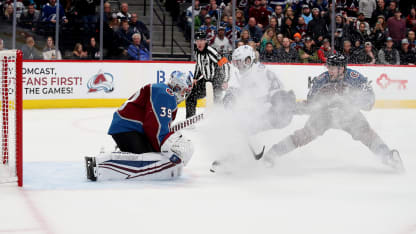The League has installed the system in 26 arenas and has a timeline for installing it in the rest. It has tested the system for a period in nine games since Feb. 6 and is scheduled to test it for a period in 11 more games this month.
Steve McArdle, NHL executive vice president of digital media and strategic planning, said there have been no issues. The testing at this point is more about the people using the system than the system itself.
"It's about making sure the equipment manager is really appropriate when they put the tags in with the jerseys," McArdle said Tuesday after updating the general managers at their annual meeting here. "This is about making sure the folks in the box know the right process to activate the puck before it's given to the referee and put into play.
"We're very comfortable with the system."
Data and graphics will be available to TV broadcasters for each game in the playoffs, including puck and player positioning, puck and player speed, shot and skating distance, time on ice, shift length, and zone time.
"There's no formula yet as to how frequent they use it live versus intermission versus in replay," McArdle said. "It will be an evolving art as we move through the playoffs."
The full rollout will come next season on more platforms with more metrics, such as save percentage by distance, location and positioning; shot speeds, types and locations; team possession times; and zone entries and exits.
McArdle said the long-term goal is "to create digital products that allow fans to go as deep as they want to go, to turn some of these aspects on or off on demand."
The NHL has spent years and tens of millions of dollars developing the system, which uses sensors in pucks and on players to create hundreds of data points per second. TV broadcasters experimented with it at the NHL All-Star Game each of the past two seasons.
"We're continuing to test it, and we have to install the capability in every building, and we have to make sure in every building it's working as it's intended to do," Commissioner Gary Bettman said in November. "And it's just a time-consuming process. …
"This is going to be a work in progress. We want the basic technology to work, which we believe it will, and then we're going to figure out how best to use it."
McArdle said the NHL has gone to great lengths to make sure it is comfortable with how the puck performs. He showed the GMs a video of the puck being shot into a wall at 170 miles per hour.
"There was no damage to the puck," he said.
Then he showed them videos of the current puck and the new puck being shot into a crossbar at 100 miles an hour, comparing the two and testing various points of failure, such as the edge of the puck.
"We're doing a lot of third-party testing to make sure the puck is performing within the specs that we would expect it to perform," he said.
McArdle said the NHL had received no complaints about the puck in live game situations, and he shared an anecdote about a player who couldn't tell the difference.
A game puck has the NHL shield on one side and the home team logo on the other. In testing, the NHL used pucks with the shield on both sides. During a game, a goalie caught a puck, then flipped it in his glove, then flipped it again.
"Turns out, he had a superstition of handing the puck back to the official with the team logo side up, and he couldn't figure out where the team logo was," McArdle said. "That was really the only incident that we've observed."

